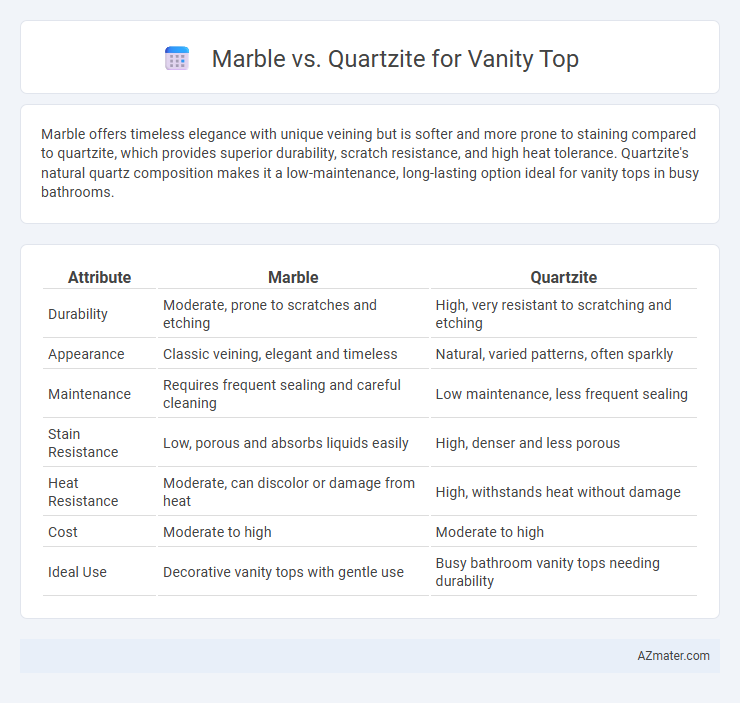Marble offers timeless elegance with unique veining but is softer and more prone to staining compared to quartzite, which provides superior durability, scratch resistance, and high heat tolerance. Quartzite's natural quartz composition makes it a low-maintenance, long-lasting option ideal for vanity tops in busy bathrooms.
Table of Comparison
| Attribute | Marble | Quartzite |
|---|---|---|
| Durability | Moderate, prone to scratches and etching | High, very resistant to scratching and etching |
| Appearance | Classic veining, elegant and timeless | Natural, varied patterns, often sparkly |
| Maintenance | Requires frequent sealing and careful cleaning | Low maintenance, less frequent sealing |
| Stain Resistance | Low, porous and absorbs liquids easily | High, denser and less porous |
| Heat Resistance | Moderate, can discolor or damage from heat | High, withstands heat without damage |
| Cost | Moderate to high | Moderate to high |
| Ideal Use | Decorative vanity tops with gentle use | Busy bathroom vanity tops needing durability |
Introduction: Marble vs Quartzite for Vanity Tops
Marble and quartzite are popular choices for vanity tops due to their durability and aesthetic appeal. Marble offers classic elegance with unique veining patterns, while quartzite provides superior hardness and resistance to scratches and stains. Selecting between marble and quartzite depends on the desired balance of beauty, maintenance, and longevity for bathroom surfaces.
Understanding Marble: Features and Composition
Marble is a natural metamorphic rock primarily composed of recrystallized carbonate minerals, typically calcite or dolomite, resulting in a smooth, elegant surface with unique veining patterns. Its porous structure makes it susceptible to staining and etching from acidic substances, requiring regular sealing and maintenance for durability in vanity tops. The classic aesthetic appeal of marble, combined with its softness compared to quartzite, offers a luxurious option for vanity surfaces but demands careful upkeep to preserve its pristine appearance.
Defining Quartzite: Characteristics and Properties
Quartzite is a natural metamorphic rock formed from sandstone subjected to intense heat and pressure, resulting in an exceptionally hard and durable surface ideal for vanity tops. Its high resistance to scratches, heat, and etching makes it a practical choice compared to marble, which is softer and more porous. Quartzite typically features a granular texture with a wide range of colors and veining patterns that can closely resemble marble, offering both aesthetic appeal and long-lasting functionality.
Appearance and Aesthetic Appeal
Marble offers a timeless elegance with its smooth, veined patterns and glossy finish, creating a luxurious and classic look for vanity tops. Quartzite mimics marble's beauty but provides a more durable, natural stone texture with subtle variations in color and veining, enhancing a sophisticated and organic aesthetic. The choice between marble and quartzite balances visual appeal with resilience, as quartzite maintains its shine and structural integrity longer under daily use.
Durability and Longevity Comparison
Quartzite offers superior durability and longevity compared to marble, as it is a natural stone composed primarily of quartz, making it highly resistant to scratches, heat, and etching from acidic substances. Marble, while elegant, is softer and more porous, prone to staining, scratching, and etching, especially in high-traffic areas like bathroom vanity tops. For homeowners seeking a long-lasting, low-maintenance vanity surface, quartzite provides a more resilient option with enduring aesthetic appeal.
Maintenance Requirements: Marble vs Quartzite
Marble vanity tops require regular sealing and gentle cleaning with pH-neutral products to prevent staining and etching due to their porous nature and calcium carbonate composition. Quartzite offers higher durability and resistance to heat, scratches, and acids, demanding less frequent sealing and simpler maintenance routines with mild soap and water. Both materials benefit from immediate spill cleanup to preserve aesthetic appeal, but quartzite provides a more practical low-maintenance option for busy bathroom environments.
Stain and Scratch Resistance
Quartzite offers superior stain and scratch resistance compared to marble, making it a more durable choice for vanity tops in high-traffic bathrooms. While marble is prone to etching and staining due to its calcite composition, quartzite's quartz-rich mineral structure provides enhanced hardness and resistance to acids and daily wear. This natural toughness ensures quartzite maintains a polished look longer with minimal maintenance.
Cost Factors and Investment Value
Marble vanity tops typically cost between $40 to $100 per square foot, making them a more affordable choice initially compared to quartzite, which ranges from $70 to $150 per square foot due to its durability and rarity. Quartzite offers higher investment value because of its superior resistance to heat, scratches, and etching, extending the lifespan of the vanity top with minimal maintenance. While marble may require more frequent sealing and care, quartzite's long-term durability justifies its higher upfront cost for homeowners seeking lasting elegance.
Suitability for Bathroom Environments
Marble offers classic elegance and natural veining but is more porous and prone to staining, making it less ideal for high-moisture bathroom environments without regular sealing. Quartzite, being denser and more resistant to scratches, heat, and moisture, provides superior durability for vanity tops in bathrooms exposed to water and humidity. Its non-porous nature reduces the risk of mold and mildew, enhancing long-term suitability for wet areas.
Conclusion: Choosing the Right Vanity Top Material
Quartzite offers superior durability and resistance to scratches and heat, making it an ideal choice for bathroom vanity tops compared to marble. Marble's elegant appearance and unique veining appeal to those prioritizing aesthetics but require careful maintenance to prevent staining or etching. Selecting between marble and quartzite ultimately depends on balancing desired beauty with long-term durability and maintenance preferences.

Infographic: Marble vs Quartzite for Vanity Top
 azmater.com
azmater.com